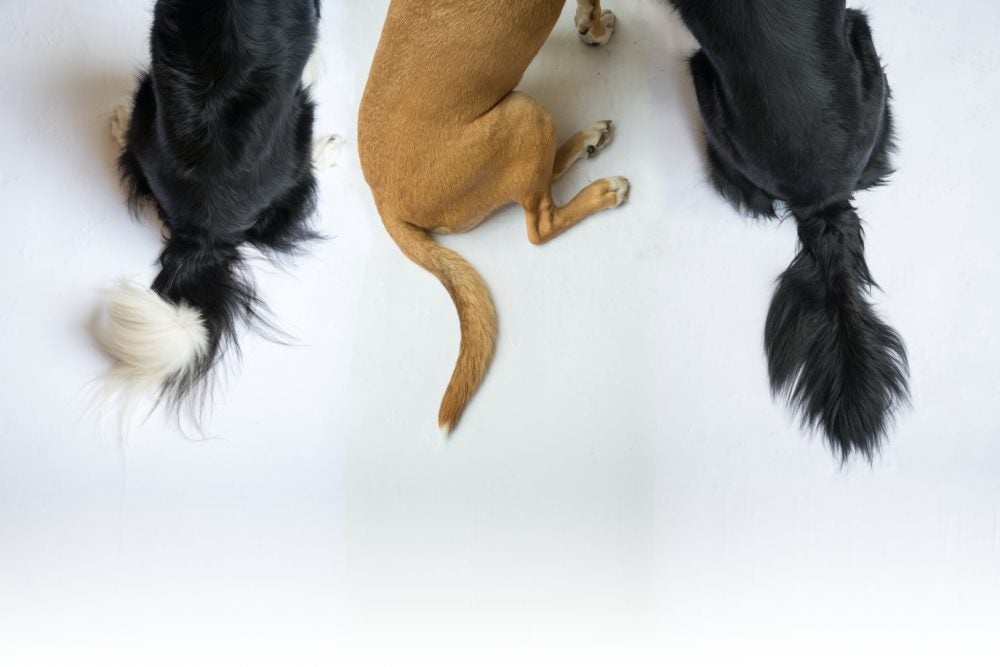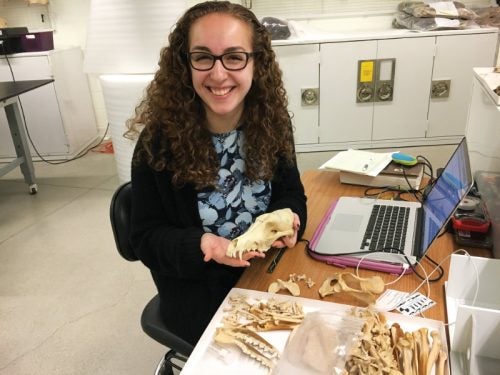
Dogs wag their tails. It’s how we know they’re happy. But does that behavior separate your best friend from a wolf? Kate Fish thinks it might. And she spent her summer at the American Museum of Natural History in New York City gathering data to test her theory.
Kate Fish ’20 was working as a research assistant for URI anthropology professor Holly Dunsworth a couple years ago when crews cleaning the Ranger Hall attic uncovered a cache of animal skeletons. Fish’s job was to clean the skeletons, identify them, and prepare them for storage. But many of the skeletons were postcranial–meaning they were missing their skulls.
The easiest way to identify an animal skeleton is by the skull. “If you have the head of a dog, you know you have a dog. If you have the head of wolf, you know you have a wolf–or a pig, or whatever,” says Dunsworth.
Among the postcranial skeletons was a canid. Lacking a skull, it was nearly impossible to determine if it was a wild or a domesticated canid. That got Dunsworth and Fish thinking: How else would you identify canid skeletons? What distinguishes wolves and coyotes from domestic dogs?

“I started thinking about tail-wagging,” says Fish, who’s majoring in biology and anthropology. “While wolves do wag their tails, it is not a habitual behavior as it is for domestic dogs, who constantly communicate this way with humans. Habitual tail-wagging could influence the development of the skeleton, just as habitual tennis-playing influences the morphology of the racket-wielding arm.”
Fish identified the muscles involved in tail posture and wagging and where those muscles attach to the skeleton. She designed measurements to compare differences between domestic and wild canids.
Last summer at the American Museum of Natural History, with support from a URI College of Arts and Sciences Fellowship, Fish measured the bones of 87 skeletons from seven canid species; she did similar work the previous summer at the Harvard Museum of Comparative Zoology. She’s looked at skeletons large and small–multiple dog breeds and wild canids from wolves to foxes–to make allowances for size. She’s also examined skeletons for signs of osteoarthritis, testing an assumption that domestic dogs could be prone to arthritis from habitual tail wagging.
She is doing preliminary analysis of the data she’s gathered over the past two summers, using Excel to run statistics and create graphs. This fall, she will take a high-level statistics course to learn how to analyze the data using a coding language.
If her theory plays out, Fish, whose interest in skeletons was sparked by the TV series Bones, plans to write a research paper and submit it for publication. “I still have a lot of data to analyze,” says Fish, “but with what I have done so far, I am seeing marginal differences in the bone anatomy that could verify my hypothesis about tail-wagging.”
Fish’s study on postcranial identification could add a new tool for researchers at archaeological sites who find canid skeletons without skulls.
“According to the published literature,” says Dunsworth, “Kate’s the first person to investigate a link to tail behavior.” •
– Tony LaRoche ’95
